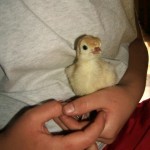This article originally appeared in the March 21, 2016 edition of The Journal Leader.
Easter is right around the corner and in the past couple weeks, I have seen multiple advertisements with chicks for sale. Often people will purchase chicks as temporary pets to entertain children as a part of celebrating Easter, but before long, these adorable little balls of fluff begin to hit puberty and turn into ragamuffin teenage birds. At this point they often lose their appeal and those who bought these cuties begin looking for a way out of keeping them.
“If only more buyers would be investors!” I have thought to myself. Raising an animal is a great way to teach a child responsibility and get a return on your investment (eggs or meat). Of all the types of livestock to undertake as a starter project, poultry is one of the easiest. In addition, the initial investments and maintenance costs are low compared to those for larger types of livestock. From my point of view, one of the most appealing aspects of raising poultry is that you can have a marketable product very quickly. Market broiler chicks can reach ready to eat weight in 5-6 weeks. At 20-24 weeks roosters reach maturity and hens begin laying eggs. You can even have a market ready turkey at 22 weeks.
If you find yourself considering purchasing chicks, here is some important information to be aware of before you buy:
- You will need to check local ordinances, zoning laws, and property association rules to make sure raising and keeping poultry is permitted in your area.
- Check if you are buying market birds or layers. Also check if they have been sexed (gender identified) or not. Birds sold in a straight run have not been sexed and your ratio of males to females is luck of the draw.
- Baby chicks need to be kept warm and dry. Without a mother hen, you will need to supply a safe, warm, and confined area to keep the chicks for the first few weeks. This area should include clean bedding, access to clean water and feed, and a heating lamp.
- Some of your chicks may die. There are many reasons why you may lose a percentage of your chicks (in these conditions, 20% is common). When mortality occurs, remove and dispose of the bird immediately and ensure that everything within the chicks’ environment is clean.
- As the birds mature they will need different types of feed (starter feed, then grower feed, then layer feed) and additional space. There are many systems you can use to house the birds depending on your preferences. Research these systems and construct a plan before you buy your birds.
These are just a few important tips. Call, click, or stop by the Noble County Extension Office if you are interested in starting poultry. There is a wealth of information available on this subject and I would be happy to help you find it.
If you are curious about what types of poultry are available and/or are interested in buying, try contacting Meyer Hatchery of Polk, OH (www.meyerhatchery.com) or Mt. Healthy Hatchery (www.mthealthy.com) of Cincinnati, OH. Both hatcheries are reputable suppliers, locally owned and operated, and offer a wide selection of birds for purchase.
